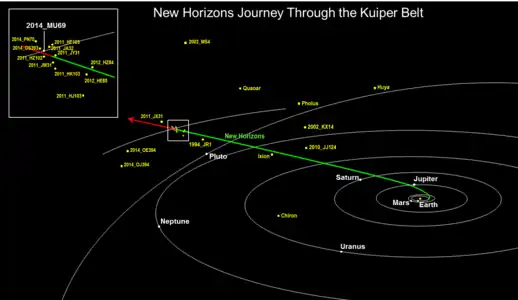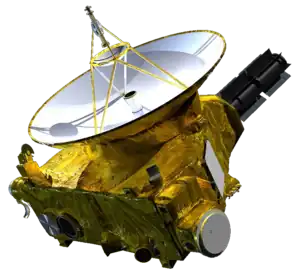.gif) 2014 OS393 imaged by the New Horizons spacecraft on 5 January 2019 | |
| Discovery[1] | |
|---|---|
| Discovered by | New Horizons KBO Search |
| Discovery site | Hubble Space Telescope |
| Discovery date | 30 July 2014 |
| Designations | |
| 2014 OS393 | |
| e31007AI[2] · e3[3] · PT2[3] | |
| TNO[4] · cubewano[5] distant[1] · binary[6] | |
| Orbital characteristics[4] | |
| Epoch 8 August 2014 (JD 2456877.5) | |
| Uncertainty parameter 8 | |
| Observation arc | 121 days |
| Aphelion | 45.350 AU |
| Perihelion | 42.534 AU |
| 43.942 AU | |
| Eccentricity | 0.0320 |
| 291.29 yr (106,394 d) | |
| 60.464° | |
| 0° 0m 12.24s / day | |
| Inclination | 3.8151° |
| 138.21° | |
| 78.660° | |
| Physical characteristics | |
Mean diameter | 30 km (component)[7] 42 km (effective)[6] |
| 36.214 h (1.5089 d)[6] | |
| 0.04–0.10[2] 0.04–0.15[8] | |
| V–I = 1.18[9][10] | |
| 25.8[9] | |
| 10.1[1] 10.111[4] | |
2014 OS393, unofficially designated e31007AI, e3 and PT2, is a binary trans-Neptunian object in the classical Kuiper belt, the outermost region of the Solar System. It was first observed by the New Horizons KBO Search using the Hubble Space Telescope on 30 July 2014.[1] Until 2015, when the object 486958 Arrokoth was selected, it was a potential flyby target for the New Horizons probe.[3] Estimated to be approximately 42 kilometres (26 mi) in diameter,[5] the object has a poorly determined orbit as it had been observed for only a few months.[4]
Discovery and designation

2014 OS393 was discovered by the New Horizons Search Team with the help of the Hubble Space Telescope[11] because the object has a magnitude of 26.3, which is too faint to be observed by ground-based telescopes. Preliminary observations by the HST searching for KBO flyby targets for the New Horizons probe started in June 2014, and more intensive observations continued in July and August.[12][13] 2014 OS393 was first discovered in observations on July 30, 2014, but it was designated e31007AI at the time, nicknamed e3 for short.[3][8] Its existence as a potential target of the New Horizons probe was revealed by NASA in October 2014[14][15] and designated PT2, but the official name 2014 OS393 was not assigned by the Minor Planet Center until March 2015 after better orbit information was available.[3]
Orbit and classification
2014 OS393 is a trans-Neptunian object and likely a non-resonant classical Kuiper belt object, also known as "cubewano".[5] It orbits the Sun at a distance of 42.5–45.4 AU once every 291 years and 3 months (106,394 days; semi-major axis of 43.94 AU). Its orbit has an eccentricity of 0.03 and an inclination of 4° with respect to the ecliptic.[4] As this object has not been observed since October 2014, its orbit remains poorly determined still containing a high uncertainty.[1][4]
The body's observation arc begins with a precovery taken on 25 June 2014, by the New Horizons KBO Search team using the Subaru Telescope at Mauna Kea Observatory on Hawaii.[1]
Binary
After the New Horizons probe completed its flyby of Arrokoth, the probe began observations of other nearby surrounding Kuiper belt objects, including 2014 OS393. Observations of 2014 OS393's brightness variations at high phase angles allowed the New Horizons probe to make a rough determination of its rotation period as well as its shape. As New Horizons observed 2014 OS393 at phase angles near 90°, it displayed large variations in brightness, indicating that its shape is either extremely elongated or 2014 OS393 could be a binary system of two separated components. 2014 OS393 appeared to be possibly a separated binary in a few resolved New Horizons images, but in 2020 this remained inconclusive.[16]
Later work by Hal Weaver in 2021 showed that 2014 OS393 is indeed a binary, with two components about 30 km (19 mi) in diameter, about 150 km (93 mi) apart.[17][7]
Exploration

After the New Horizons probe completed its flyby of Pluto, the probe was to be maneuvered to a flyby of at least one Kuiper belt object. Several potential targets were under consideration for the first such flyby. 2014 OS393 has an estimated mean-diameter between 30 and 55 kilometers, depending on the body's assumed albedo.[5][8] The potential encounter in 2018–2019 would have been at a distance of 43–44 AU from the Sun.[2]
On 28 August 2015, the New Horizons team announced the selection of 2014 MU69 (later named 486958 Arrokoth) as the next flyby target, eliminating the other possible targets — 2014 OS393, 2014 PN70, and 2014 MT69.[3][18][19]
The spacecraft passed 2014 OS393 in January 2019, at a distance of less than 0.1 AU (15 million km, 9.3 million miles). This makes 2014 OS393 the second closest KBO observed by New Horizons, after Arrokoth.[20]
Numbering and naming
This minor planet has not been numbered by the Minor Planet Center and remains unnamed.[1]
See also
- 2011 JY31, another tight binary KBO observed by New Horizons
- List of New Horizons topics
References
- 1 2 3 4 5 6 7 "2014 OS393". Minor Planet Center. Retrieved 7 September 2021.
- 1 2 3 Lakdawalla, Emily (15 October 2014). "Finally! New Horizons has a second target". Planetary Society blog. Planetary Society. Archived from the original on 15 October 2014.
- 1 2 3 4 5 6 Zangari, Amanda (28 March 2015). "Postcards from Pluto". Tumblr.
- 1 2 3 4 5 6 "JPL Small-Body Database Browser: (2014 OS393)" (2014-10-24 last obs.). Jet Propulsion Laboratory. Retrieved 7 September 2021.
- 1 2 3 4 Johnston, Wm. Robert (18 August 2020). "List of Known Trans-Neptunian Objects". Johnston's Archive. Retrieved 7 September 2021.
- 1 2 3 Weaver, H. A.; Porter, S. B.; Spencer, J. R.; et al. (February 2022). "High Resolution Search for KBO Binaries from New Horizons". The Planetary Science Journal. 3 (46): 17. arXiv:2201.05940. Bibcode:2022PSJ.....3...46W. doi:10.3847/PSJ/ac4cb7. S2CID 247088149.
- 1 2 Dickinson, David (8 October 2021). "New Horizons Discovers Kuiper Belt "Twins"". Sky & Telescope. Retrieved 13 November 2021.
- 1 2 3 Buie, Marc (15 October 2014). "New Horizons HST KBO Search Results: Status Report" (PDF). Space Telescope Science Institute. p. 23. Archived from the original (PDF) on 27 July 2015. Retrieved 6 June 2015.
- 1 2 Benecchi, S. D.; Borncamp, D.; Parker, A. H.; Buie, M. W.; Noll, K. S.; Binzel, R. P.; et al. (December 2019). "The color and binarity of (486958) 2014 MU69 and other long-range New Horizons Kuiper Belt targets". Icarus. 334: 22–29. arXiv:1812.04752. doi:10.1016/j.icarus.2019.01.025. S2CID 119192900.
- ↑ "LCDB Data for (2014+OS393)". Asteroid Lightcurve Database (LCDB). Retrieved 7 September 2021.
- ↑ J. R. Spencer; M. W. Buie; et al. (2015). "The Successful Search for a Post-Pluto KBO Flyby Target for New Horizons Using the Hubble Space Telescope" (PDF). European Planetary Science Congress (EPSC) Abstract. Copernicus Office: EPSC2015-417. Bibcode:2015EPSC...10..417S.
- ↑ "Hubble to Proceed with Full Search for New Horizons Targets". HubbleSite news release. Space Telescope Science Institute. 1 July 2014.
- ↑ Schmidt, Klaus (2 July 2014). "Hubble to Proceed with Full Search for New Horizons Targets". International Space Fellowship.
- ↑ "NASA's Hubble Telescope Finds Potential Kuiper Belt Targets for New Horizons Pluto Mission". HubbleSite. 15 October 2014.
- ↑ Wall, Mike (15 October 2014). "Hubble Telescope Spots Post-Pluto Targets for New Horizons Probe". Space.com. Archived from the original on 15 October 2014.
- ↑ Porter, S. B.; Verbiscer, A. J.; Weaver, H. A.; Spencer, J. R.; Kavelaars, J. J.; Singer, K. N.; Parker, J. W.; Stern, S. A. (2020). Shapes of TNOs from New Horizons Lightcurves (PDF). 51st Lunar and Planetary Science Conference. Lunar and Planetary Institute. 1645. Retrieved 28 February 2020.
- ↑ Weaver, Harold; Porter, Simon; Spencer, John (October 2021). Discovery of Tight Binaries in the Kuiper Belt by New Horizons LORRI. 53rd Annual DPS Meeting. Vol. 53. American Astronomical Society. Bibcode:2021DPS....5330707W. 307.07.
- ↑ Powell, Corey S. (29 March 2015). "Alan Stern on Pluto's Wonders, New Horizons' Lost Twin, and That Whole "Dwarf Planet" Thing". Discover. Archived from the original on 16 November 2019. Retrieved 8 May 2015.
- ↑ Cofield, Calla (28 August 2015). "Beyond Pluto: 2nd Target Chosen for New Horizons Probe". Space.com.
- ↑ S. A. Stern; H. A. Weaver; J. R. Spencer; H. A. Elliott (2016). "The New Horizons Kuiper Belt Extended Mission". Space Science Reviews. 214 (4). arXiv:1806.08393. doi:10.1007/s11214-018-0507-4. S2CID 255074224.
External links
- List of Transneptunian Objects, Minor Planet Center
- 2014 OS393 at the JPL Small-Body Database
